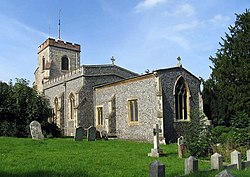Aston, Hertfordshire
| Aston | |
| Hertfordshire | |
|---|---|
 St Mary, Aston | |
| Location | |
| Grid reference: | TL273226 |
| Location: | 51°53’16"N, 0°9’6"W |
| Data | |
| Population: | 844 (2001) |
| Post town: | Stevenage |
| Postcode: | SG2 |
| Local Government | |
| Council: | East Hertfordshire |
Aston is a village in Hertfordshire, close by but as yet unabsorbed by the swollen new town of Stevenage. According to the 2001 census it had a population of 844.
Aston sits on a ridge between Stevenage and the Beane Valley, and is just 10 minutes' drive from the A1(M).
A mile north of Aston lies Aston End, a hamlet which has strong social and geophysical ties with the village. Hooks Cross, another hamlet in the Parish, straddles the A602 Stevenage to Hertford road.
Aston is known locally for its conviviality and, despite its modest size, boasts a great many clubs, societies and interest groups as well as hosting a very successful annual school fete.
During the reign of Edward the Confessor (1024–66), the manor of "Estone" was held by three vassals of Stigand, Archbishop of Canterbury. Their names are not known but some land is recorded as that of Wulf the Dane.
Parish church
The parish church is St Mary's. The oldest part of the church is the chancel, built in about 1230. The church is built of flint with stone dressings on the nave and chancel. The roofs are sheathed in copper, though the original roof was thatched and the ridge marks of this roof can still be seen on the east side of the tower.
The chancel and nave probably represent the whole of the original church and it was not until the beginning of the 15th century that the west tower was added. At about this time it became known as St Mary's; older records call the church "St James".
History
The Domesday Book of 1086 records that Estone was made up of about twenty-five families and included a priest. So it seems that there was a church at that time and it was almost certainly on the site of the present Aston St Mary's.
King William I gave 185 manors, including that of Estone, to his ruthless and ambitious half-brother Odo, Bishop of Bayeux. Odo's deceptions, and his burning aspiration to become Pope, so offended the King that he was sentenced to perpetual imprisonment. His treasures and estates, including Estone, reverted to the Crown
The manor, now in Royal possession, was presented by King Henry I in dower to his second wife, Adeliza, on their marriage in 1121.
In that same year Henry founded the Reading Abbey and after the King died in 1135, the Dowager Queen visited Reading Abbey on the first anniversary of her husband's death and bestowed on the Abbot and Monks of the Monastery the gift of Easton Manor.
Easton, so named at this time, remained under monastic control for three hundred years until the Dissolution (1536–39), when Henry VIII gave the manor of "Aston", for the tenth part of a Knight's fee, and a rent of seventeen shillings and eleven pence, to the local favourite Sir Philip Boteler, Sheriff of Hertford.
Sir Philip ruled at Woodhall in the contiguous parish of Watton. To establish himself on his new territory, he chose the site of a ruined building, probably of monastic origin and, using some of the structure and stone from the ruin, he built the manor house which we now know as Aston Bury.
During World War II, Aston House, opposite the church (demolished in the 1960s) was occupied by the Special Operations Executive, engaged in the design, testing and production of explosives and secret weapons for use in sabotage operations and guerilla warfare. See SOE's Secret Weapons Centre STATION 12 - Author Des Turner, for full story.
Outside links
| ("Wikimedia Commons" has material about Aston, Hertfordshire) |